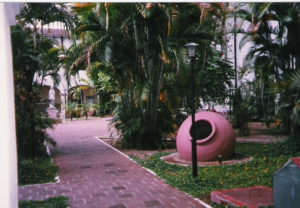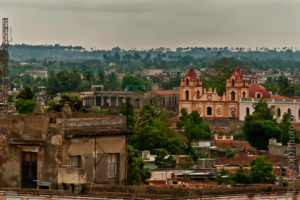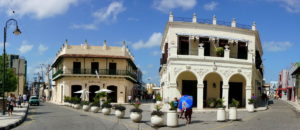CAMAGUEY, CUBA: HISTORIC “CITY OF THE CLAY POTS”. PHOTOS.
Camagüey (Spanish pronunciation: [kamaˈɣwej]) is a city and municipality in central Cuba and is the nation’s third largest city with more than 321,000 inhabitants. It is the capital of the Camagüey Province.
After almost continuous attacks from pirates the original city (founded as Santa María del Puerto del Príncipe around 1515 on the northern coast) was moved inland in 1528. The new city was built with a confusing lay-out of winding alleys. There are many blind alleys and forked streets that lead to squares of different sizes. One explanation is that this was done by design, to make the city easier to defend from any raiders; by the same version, the reason that there is only one exit from the city was that should pirates ever return and succeed in entering the city, it would be possible for local inhabitants to entrap and kill them.
The clay pots in Camagüey
The symbol of the city of Camagüey is the clay pot or tinajón, used to capture rain water to be used later, keeping it fresh. Clay pots are everywhere, some as small as a hand, some large enough for two people to stand up in, either as monuments or for real use. Local legend has it that if you drink water from a girl’s personal tinajón, you will fall in love with the girl and never leave her.
In July 2008, the old town was designated a UNESCO World Heritage Site.
In 2004, the municipality of Camagüey had a population of 324,921. With a total area of 1,106 km2 (427 sq mi), it has a population density of 293.8/km2 (761/sq mi).
The old city layout resembles a real maze, with narrow, short streets always turning in a direction or another. After Henry Morgan burned the city in the 17th century, it was designed like a maze so attackers would find it hard to move around inside the city.
Camagüey is the birthplace of Ignacio Agramonte (1841), an important figure of the Ten Years’ War against Spain in 1868–1878.
The outline of Ignacio Agramonte’s horseback statue in the Park that bears his name is a symbol of Camagüey. It was set there in 1911, uncovered by his widow, Amalia Simoni.
Artists include José Iraola, a contemporary painter who was born in Camagüey, on September 19, 1961, and sculptor Roberto Estopiñán, born in Camagüey, in 1921.
The city is the birthplace of Major League Baseball Hall of Fame member Atanasio Perez Rigal (Tony Pérez), who won two World Series titles with the Cincinnati Reds and was the 1967 All Star Game MVP.
The city is also the birthplace of the Cuban national poet Nicolás Guillén; also of Carlos J. Finlay, an outstanding physician and scientist, who first identified the Aedes aegyptis mosquito as the vector of the Yellow Fever.
Camagüey is also the hometown of volleyball player Mireya Luis, Gertrudis Gomez de Avellanada (poet), Silvestre de Balboa (1563–1649, writer), Salvador Cisneros Betancourt, Marqués de Santa Lucia (Cuban patriot, signatory of the Guaimaro Constitution of 1869 and President of the Cuban Republic in Arms).
Father José Olallo Valdés worked there, and was beatified in the city on November 29, 2008.
Olympic champion amateur boxer at 75 kg in Sydney 2000 was Jorge Gutiérrez Espinosa, born 18 September 1975 in Camagüey.
Birthplace of the Cuban writer, Severo Sarduy—a member of the European intellectual community that consolidated in the 1960s behind the journal of critical thought, Tel Quel. Sarduy, censored in Cuba throughout the 20th century, lived in Paris as an exile from 1960 until his death in 1993. He holds the position within literary history of having reformulated the transatlantic reconfigurations of the Hispanic Baroque aesthetic under the term “Neobaroque”.
CAMAGÜEY, CUBA: “LA HISTÓRICA CIUDAD DE LOS TINAJONES”. FOTOS.
Camagüey es una ciudad y municipio en el centro de Cuba y es la tercera ciudad más grande del país con más de 321.000 habitantes. Es la capital de la provincia de Camagüey.
Después de ataques casi continuos de piratas, la ciudad original (fundada como Santa María del Puerto del Príncipe hacia 1515 en la costa norte) fue trasladada al interior en 1528. La nueva ciudad fue construida con un confuso trazado de callejones sinuosos. Hay muchos callejones sin salida y calles bifurcadas que conducen a plazas de diferentes tamaños. Una explicación es que esto fue hecho por diseño, para hacer la ciudad más fácil de defender de cualquier asaltantes; Por la misma versión, la razón de que sólo hay una salida de la ciudad era que si los piratas alguna vez volvieran y consiguieran entrar en la ciudad, sería posible que los habitantes locales los atraparan y los mataran.
Las ollas de arcilla en Camagüey
El símbolo de la ciudad de Camagüey es la olla de arcilla o tinajón, utilizada para capturar el agua de lluvia para ser utilizada posteriormente, manteniéndola fresca. Las ollas de barro están por todas partes, algunas tan pequeñas como una mano, algunas lo suficientemente grandes como para que dos personas puedan levantarse, ya sea como monumentos o para uso real. La leyenda local dice que si tomas agua del tinajón personal de una chica, te enamorarás de la chica y nunca la dejarás.
En julio de 2008, el casco antiguo fue declarado Patrimonio de la Humanidad por la UNESCO.
En 2004, el municipio de Camagüey tenía una población de 324.921 habitantes. Con una superficie total de 1.106 km2 (427 sq mi), tiene una densidad de población de 293.8 / km2 (761 / sq mi).
El diseño de la vieja ciudad se asemeja a un verdadero laberinto, con calles estrechas y cortas siempre girando en una dirección u otra. Después de que Henry Morgan quemara la ciudad en el siglo XVII, fue diseñado como un laberinto para que los atacantes tuvieran dificultades para moverse dentro de la ciudad.
Camagüey es el lugar de nacimiento de Ignacio Agramonte (1841), una figura importante de la Guerra de los Diez Años contra España en 1868-1878.
El contorno de la estatua de caballo de Ignacio Agramonte en el Parque que lleva su nombre es un símbolo de Camagüey. Fue establecido allí en 1911, descubierto por su viuda, Amalia Simoni.
Los artistas son José Iraola, pintor contemporáneo nacido en Camagüey el 19 de septiembre de 1961, y el escultor Roberto Estopiñán, nacido en Camagüey, en 1921.
La ciudad es el lugar de nacimiento del miembro del Salón de la Fama del Béisbol de la Liga Mayor Atanasio Pérez Rigal (Tony Pérez), quien ganó dos títulos de la Serie Mundial con los Rojos de Cincinnati y fue el MVP del Juego de Estrellas de 1967.
La ciudad es también el lugar de nacimiento del poeta nacional cubano Nicolás Guillén; También de Carlos J. Finlay, un destacado médico y científico, que identificó por primera vez el mosquito Aedes aegyptis como el vector de la fiebre amarilla.
Camagüey es también la ciudad natal de la futbolista Mireya Luis, Gertrudis Gómez de Avellanada (poeta), Silvestre de Balboa (1563-1649), Salvador Cisneros Betancourt, Marqués de Santa Lucía (patriota cubano, signatario de la Constitución Guaimaro de 1869 y Presidente de la República Cubana en Armas).
El padre José Olallo Valdés trabajó allí y fue beatificado en la ciudad el 29 de noviembre de 2008.
Campeón olímpico boxeador aficionado de 75 kg en Sydney 2000 fue Jorge Gutiérrez Espinosa, nacido el 18 de septiembre de 1975 en Camagüey.
Lugar de nacimiento del escritor cubano Severo Sarduy -un miembro de la comunidad intelectual europea que se consolidó en los años sesenta detrás de la revista de pensamiento crítico Tel Quel. Sarduy, censurado en Cuba a lo largo del siglo XX, vivió en París como exiliado desde 1960 hasta su muerte en 1993. Tiene la posición dentro de la historia literaria de reformular las reconfiguraciones transatlánticas de la estética barroca hispana bajo el término Neobaroque.
Agencies/Wiki/Internet Photos/Excerpts/Arnoldo Varona/TheCubanHistory.comm
THE CUBAN HISTORY, HOLLYWOOD.










